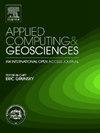Deformation analysis by an improved similarity transformation
IF 3.2
Q2 COMPUTER SCIENCE, INTERDISCIPLINARY APPLICATIONS
引用次数: 0
Abstract
In this contribution, deformation analysis is rigorously performed by a non-linear 3-D similarity transformation. In contrast to traditional methods based on linear least-squares (LLS), here we solve a non-linear problem without any linearization. To achieve this goal, a new weighted total least-squares (WTLS) approach with general dispersion matrix is implemented to deformation analysis problem. Although some researchers have been trying to solve deformation analysis using TLS approaches, these attempts require modification since they used to apply unstructured TLS techniques such as Generalized TLS (GTLS) to similarity transformation which requires structured TLS (STLS) techniques while the WTLS approach preserves the structure of the functional model when based on the perfect description of the variance-covariance matrix. As a secondary scope, here it is analytically proved that LLS is not identical to nonlinear estimations such as the WTLS methods and rigorous nonlinear least-square (RNLS) as opposed to what in some contributions has been claimed. The third attainment of this contribution is proposing another algorithm for rigorous similarity transformation with arbitrary rotational angles. It is based on the RNLS method which can obtain the correct update of misclosure. Moreover, compared to transformation methods that deal with arbitrary rotational angles, we do not need to impose any orthogonality constraints here. Two case studies numerically confirm that the WTLS and RNLS methods provide the most accurate results among the LLS, GTLS, RNLS and WTLS approaches in two landslide areas.
一种改进的相似变换变形分析方法
在这个贡献中,变形分析是通过非线性三维相似变换严格执行的。与传统的基于线性最小二乘(LLS)的方法相比,我们在没有任何线性化的情况下解决了一个非线性问题。为实现这一目标,提出了一种基于广义色散矩阵的加权总最小二乘(WTLS)方法。虽然一些研究人员已经尝试使用TLS方法解决变形分析,但这些尝试需要修改,因为他们使用非结构化TLS技术,如广义TLS (GTLS)来进行相似性转换,这需要结构化TLS (STLS)技术,而WTLS方法在基于方差-协方差矩阵的完美描述时保留了功能模型的结构。作为次要范围,本文分析证明了LLS与非线性估计(如WTLS方法和严格非线性最小二乘(RNLS))不相同,这与某些贡献中所声称的相反。这一贡献的第三个成就是提出了另一种具有任意旋转角度的严格相似变换算法。该方法基于RNLS方法,可以获得误闭的正确更新。此外,与处理任意旋转角的变换方法相比,我们在这里不需要施加任何正交性约束。两个算例表明,在两个滑坡区,WTLS和RNLS方法在LLS、GTLS、RNLS和WTLS方法中提供了最准确的结果。
本文章由计算机程序翻译,如有差异,请以英文原文为准。
求助全文
约1分钟内获得全文
求助全文
来源期刊

Applied Computing and Geosciences
Computer Science-General Computer Science
CiteScore
5.50
自引率
0.00%
发文量
23
审稿时长
5 weeks
 求助内容:
求助内容: 应助结果提醒方式:
应助结果提醒方式:


